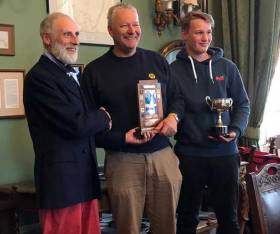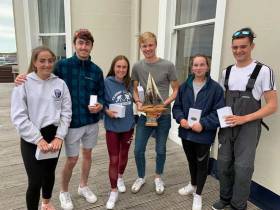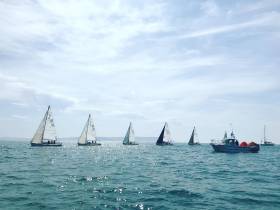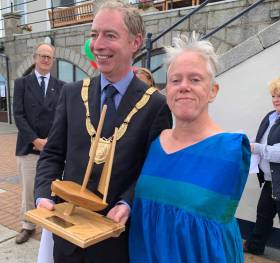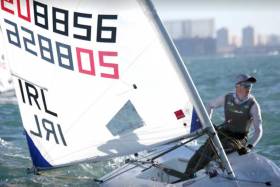Displaying items by tag: Royal St George Yacht Club
Winter Lift-Out of Boats at the National & Royal St George Yacht Clubs
The annual lift-out of yachts and boats in Dun Laoghaire Harbour at the neighbouring Royal St.George and National Yacht Clubs took place in fine weather conditions on Dublin Bay today.
Boats will be stored ashore now on club platforms for the winter period and launched again in advance of the Summer season next April.
It's not the end of Dun Laoghaire sailing, however, as Dublin Bay Sailing Club runs year-round racing for cruisers based at the town marina with its popular winter Turkey Shoot Series before Christmas and its Spring Chicken event in the new year that attracts up to 70 and 50 yachts respectively for each series.
More details of the forthcoming Turkey Shoot here.
Dublin Bay 'Final Fling' Dinghy Regatta Attracts 45 Boat Entry
The CH Marine Laser sponsored, Final Fling regatta took place in Dun Laoghaire on Saturday with a whopping 45 entries across two race courses writes Gavan Murphy,
Dun Laoghaire Laser Class Captain
Competitors were greeted by a punchy 20 knot South Westerly on Saturday morning as they came down to rig, so Regatta Fleet Race Officer, Sean Craig, wisely postponed launching his fleet by an hour to ensure they raced in optimum conditions to match their experience. This gave Sean an opportunity to do a rig set up session with some of the more apprehensive sailors in this fleet so they were confidently ready to hit the water as soon as the breeze came down.
Meanwhile, in the 34-boat, DBSC hosted Main Fleet, the weather God's attempted to make life difficult for not only the competitors but race officer, Suzanne McGarry and her mark layers, who were frequently charged with moving the weather mark and pin end to facilitate the constantly shifting and dying breeze. That said, the fleet managed to get four close races in on a windward-leeward course. In the Laser 4.7's, Archie Daly and Oisin Hughes of RSGYC were 1st and 2nd, while Christian Ennis of NYC was 3rd. In the Laser Radial's, Barry McCartin of CBSC/RSGYC showed his class with four wins from four, Conor Clancy and Kate Fahy of RSGYC were 2nd and 3rd respectively. In the Laser Standard's, Damian Maloney of the RSGYC showed a clean set of heels with three 1st places and one 2nd. Ian Simington and Robbie Walker also of the RSGYC were 2nd and 3rd respectively.
"There was a whopping 45 entries across two race courses"
On the Regatta Fleet race course, Race Officer Sean Craig managed to get 5 quick-fire races in on a short triangular course for his charge of 11 boats. In the Laser Standard class, Maurice Mason of the RSGYC took the honours with Mick Shelley, also of the RSGYC close on his heels throughout. Indeed, there was a funny incident in the last downwind leg of the last race, where both competitors main sheet's managed to run clear of the blocks at the same time....a mad scramble ensued only for Maurice to get his main sheet re-tied and got to the line just ahead of Mick. A course in stopper knot skills is duly noted for these two! In the Radial Class, Oisin Hannon, Heather Craig and Rachel Crowley of the RSGYC took the honours, while in the Laser 4.7 class, Lorraine O'Connor and Alec Munro took 1st and 2nd respectively. For the majority of the sailors in this fleet, this was their first regatta which they did remarkably well to compete in and manage so effectively. Indeed, coach Richard O'Rahilly commented he was really encouraged by the closeness of racing and boat handling ability he witnessed. We hope to see some of these sailors make the transition to frostbiting this winter and indeed on to the regatta and Laser circuit next season.
A casual prize giving took place for the Lasers on the balcony of the George after racing, thanks to CH Marine. This was followed by a Grant Thornton sponsored champagne reception, compliments of Mick Shelley and the now infamous Dun Laoghaire Laser class end of season dinner in the George that evening which was superbly attended by 30 people.
Huge thanks again to Laser prize sponsors, CH Marine; DBSC; George Sailing Manager, Ronan Adams; Race Officers, Suzanne McGarry and Sean Craig and their respective rescue and committee boat teams; namely, Shirley Gilmore, Caroline Liddy, Barbara Conway, Liz Aylmer, Hilary Bloxham and Brian Mulqueen.
George and Andrew Miller in ‘Pixie’ Win 12 Foot Dinghies Altair Trophy
The Royal St George hosted the combined International 12 Foot Dinghy Championship & D.B.S.C. 12 Ft Championship on 15th September,- a day which will be remembered both for the incessant rain, and for the tight competition. The event was held in Seapoint Bay, the original racing area for the Dublin based 12-Foot Dinghies from the 1920s and 30s. This year’s entry was reduced due to ‘Dorado’s’ owner not being available, and ‘Sgadan’ being under restoration in Tralee in preparation for next year’s ‘Clinkerfest 250’. However, the International rigs were represented by three boats. We understand that one potential owner is heading to the UK soon to purchase a Dutch-built dinghy currently for sale there.
In race one, with patchy winds of less than 4 kts George Miller’s ‘Pixie’ held the lead for the entire race, but behind her there was a great battle between ‘Albany’ (Gavin Johnson) and ‘Cora’ (Mark Delany). It was ‘Albany’ who won this battle.
In race two with a steady 5 kt. Breeze, ‘Cora’ won the start but was overtaken by the faster ‘Pixie.’ But due to an error at the finish line, ‘Cora’ regained the lead.
The dinghies were left at anchor in Seapoint Bay while the competitors came ashore for their lunch, and in some cases, extra clothing or extra waterproofing, or additional pumps.
By the afternoon the wind has increased to about 8 kts. Race 3 was won by ‘Pixie’ after a good battle with ‘Cora’ which lasted for the entire race. The improving ‘Scythian’ (David Shackleton) took third place.
The final race was to be the decider of the championship. ‘Cora’ used her team-racing skills to push ‘Pixie’ away from the start line. During the race ‘Pixie’s’ yard support broke, causing her rig to slip down 300mm and, of course, lessened her speed. As ‘Cora’ approached the finish line she slowed up with the hope of bringing ‘Scythian’ into second place and pushing ‘Pixie’ into third place, but her plan went awry, and ‘Pixie’ stole second place to win the championship.
At the prize-giving, Pat and Sheelagh McGloughlin presented the Altair Cup to Andrew Miller crew of ‘Pixie’ noting that the trophy despite being almost ninety years old, has not been won for 42 years.
The Cora trophy for international dinghies was awarded to George and Andrew Miller in ‘Pixie’.
The Edmond Johnson Ltd. Trophy for DBSC dinghies was awarded to Gavin Johnson and Tim Varian in ‘Albany’.
Vincent Delany chairman of the 12-foot organisation explained how next year’s Irish Championship with International entries will take place at Lough Ree Yacht Club over the June bank holiday weekend.
12-Foot Dinghies Prepare to Race for the ‘Altair’ Trophy at the Royal St George Yacht Club
Next Sunday the ‘Altair’ trophy will be presented to the highest placed crew in the Irish 12-foot dinghy championships to be held in the Royal St George Yacht Club writes Vincent Delany.
This trophy was originally won at the Dublin Coast Championship for International 12 Foot Dinghies, an event held in Dun Laoghaire Harbour on 21 September 1931 (although the engraving on the trophy describes it as Kingstown). This was probably the first ‘open meeting’ for a one-design class ever to be held in the Republic of Ireland. Despite none of the owners having road trailers, and the dinghies sailing from their home ports, there were fifteen entries from Howth Sailing Club, Sutton branch of Howth Sailing Club, Seapoint Boat Club and Malahide (where a sailing club was yet to be established). The event took place despite there not being an overall Class organisation to encourage entries. Perhaps things were done by word of mouth in those days. After four rounds of the Water Wag course, in a single race, the event was won by A.W. (Billy) Mooney in ‘Altair’ from Howth Sailing Club, followed by Mr. G. Bayly Spencer’s ‘Kittiwake’ from the Seapoint Boat Club, and Mr. Mc Cracken's ‘Snipe’ from Howth in third place. Mooney went on to win many races in other classes such as the Howth 17 foot class and in International Dragons.
The ‘Altair’ trophy was held by the Mooney family until 1970 when it was represented to the D.B.S.C. 12 Foot Dinghy fleet as a prize, for crews steering 12-foot dinghies. The trophy was competed for every year until 1977. It was represented to the International 12 Foot Dinghy Association of Ireland this week by the McGloughlin family.
Under event rules, 12-foot dinghies may sail either single-handed or two-handed.
'Curious George' Victorious at Fifth Elmo Trophy Youth Team Racing Event
"Curious George" from the host yacht club emerged the winners of the fifth Elmo Team Racing Trophy sailed this weekend at the Royal St George Yacht Club in Dun Laoghaire Harbour. 22 teams from all over Ireland competed in the event, with most of Ireland's top youth sailors enjoying sailing with and against each other in almost perfect team racing conditions.
Despite a slight delay waiting for wind on Sunday morning, the race team successfully completed almost 120 races over the two days.
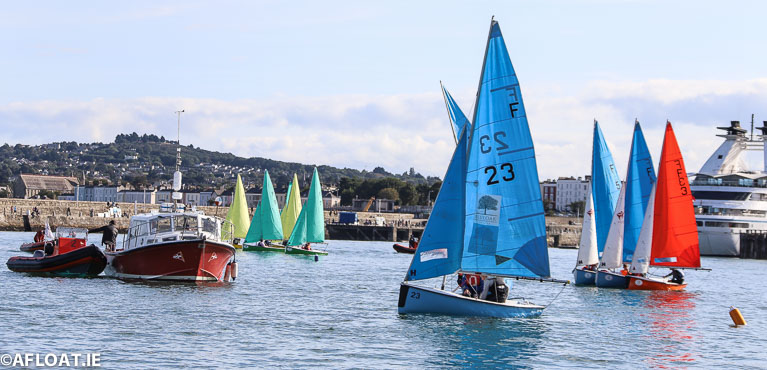 Almost 120 races took place over the two days
Almost 120 races took place over the two days
After the initial round-robin on Saturday, the teams were split into seeded fleets for racing on Sunday. Curious George (Toby Hudson Fowler, Kathy Kelly, Henry Higgins, Isabelle Kearney, Jack Fahy and Emily Riordan) narrowly beat Goats in Boats, led by last years winning captain, Tom Higgins. Showing the competitiveness of the sailing, and how our youth sailors are developing as keen team racers, the next three places had to be decided on count backs, with Morgan Lyttle's 420 Blaze it just edging ahead of George Clooney (captained by Helen O'Beirne) and Atlee Kohl's 3 Amigos. First in the Silver Fleet was Harry Twomey's RCYC team.
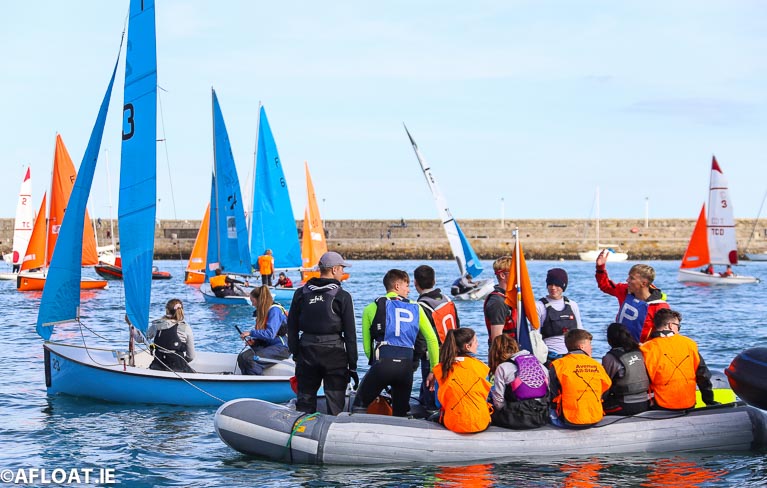 22 teams from all over Ireland competed in the event
22 teams from all over Ireland competed in the event
Raced in four flights for the first time in its 5 year history, the organisers hope this event will grow to a fifth flight and even more teams next year as youth team racing grows around the country.
Were it not for a 'DSQ' in race three, Dublin Bay helmsman Jonathan O'Dowd of the Royal St. George Yacht Club may well have been further up the podium when racing was cut short at the J80 UK National Championships in Lymington yesterday. Instead, the Irish boat took bronze in the 11-boat fleet.
As Afloat previously reported, racing in Christchurch Bay at Royal Lymington Yacht Club, in 5 - 8 knots of breeze, the Royal St. George Yacht Club entry 'Jabs' stayed third overall when the final races were abandoned.
Chris & Hannah Neve of the host club were overall winners with Nick Haigh's Slighty Steamy in second.
Overall results in the 11-boat fleet are downloadable here
Today's second day of racing at the Sailability President’s Cup and Hansa National Championships was cancelled in anticipation of more than 20 knots of breeze forecast at the Royal St George Yacht Club on Dublin Bay this morning.
As Afloat reported yesterday, the Ulster team of two Squibs, a Hansa and a 2.4m clinched the overall Presidents Cup Trophy on 36 points, just ahead of the Munster team on 37.
Just one point separated the first three places in the eighteen strong Hansa fleet. Cara O‘Sullivan (Munster) won the Hansa Nationals in style on just 6 points. Best performing youngest junior girl in the fleet went to Lucy Kinner (Ulster). Best junior boy was awarded to Jack Cunningham (Connaught) and best newcomer to Cian Nolan (Leinster).
The Spirit of Sailability trophy went to Mary Duffy for her determination and sportsmanship for competing solo in very challenging conditions yesterday.
Special thanks to our sponsors including Dun Laoghaire Rathdown County Council and Hewlett-Packard Enterprise Gold Partner Softcat also Dun Laoghaire based.
Also a huge thank you to all our volunteers, in particular, the buddy sailors, race officers and everyone who has supported the event throughout the weekend.
Royal St George YC Commodore Peter Bowring and Dun Laoghaire Rathdown Cathaoirleach Shay Brennan presented the prizes. See photos below:
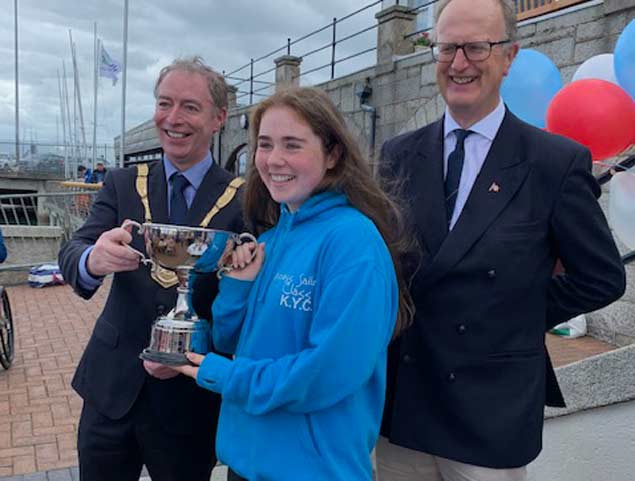 Cara O'Sullivan, Munster, winner of the Hansa Nationals
Cara O'Sullivan, Munster, winner of the Hansa Nationals
 Anne Blair Chairman of Belfast lough Sailability collecting the trophy for Team Ulster
Anne Blair Chairman of Belfast lough Sailability collecting the trophy for Team Ulster
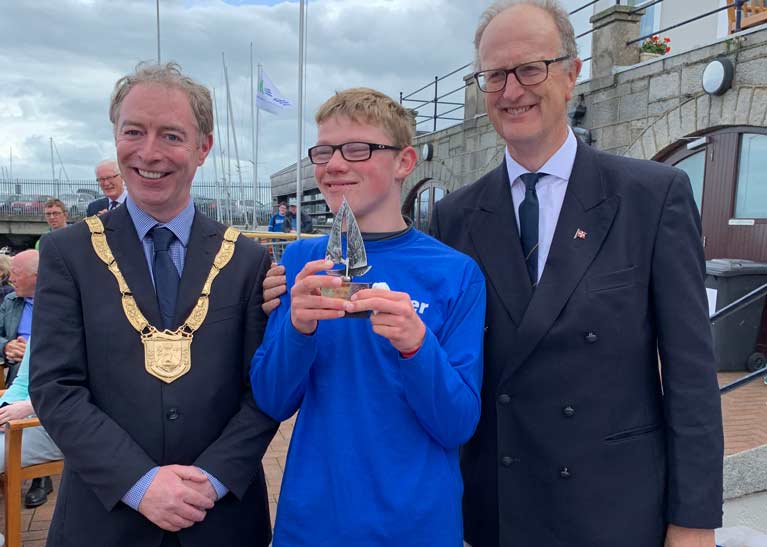 Cian Nolan, Leinster wins Best Newcomer
Cian Nolan, Leinster wins Best Newcomer 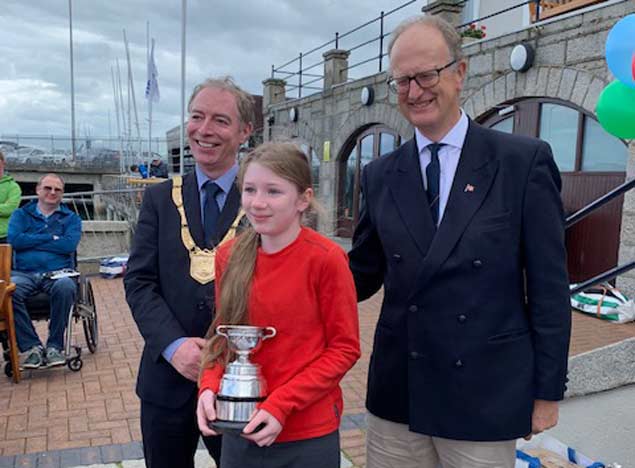 Lucy Kinner, Ulster, best performing youngest junior in Hansa
Lucy Kinner, Ulster, best performing youngest junior in Hansa
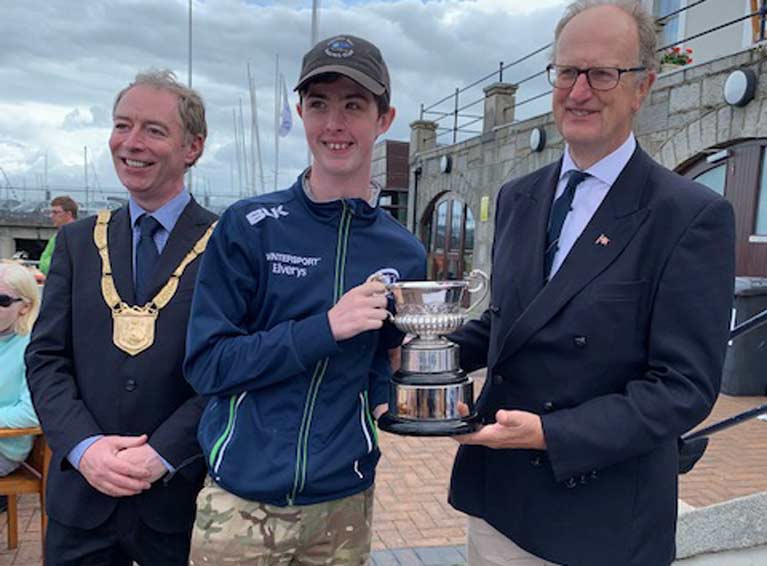 Jack Cunningham, Connaught, wins Best Junior boy
Jack Cunningham, Connaught, wins Best Junior boy
Royal Saint George Yacht Club and Under 17 sailor Tom Higgins won the Andalusian Olympic Week regatta in the Laser Radial class earlier this month.
Higgins recorded three first places and three-top three finishes overall to secure a five-point net winning margin. Sailed over four days in mixed conditions in the Bay of Cadiz Tom was part of the Academy sailing team of five sailors coached by Sean Evans. Since his return, Higgins was part of the Gonzaga Sailing team which won the Leinster Team Racing Championships held in the RStGYC earlier this month.
As well as some Europa Cup events over the next number of months the team are preparing for the Laser Radial World Championships in Kingston, Ontario. Tom finished second U17 and seventh overall at this event in 2018.
All Four Provinces Heading for ICRA National Championships at Royal St George Yacht Club
With four days to go on discounted early entries to the ICRA National Championships, a strong fleet representing fifteen clubs and all four provinces have already entered the June Championships at the Royal St. George Yacht Club on Dublin Bay.
Stepping out of a committee meeting finalising the social programme (pictured above) Event Chairman Ian Simington commented "We are really encouraged to see early entries from crews in Ulster, Connacht and Munster.
A large travelling contingent makes racing more exciting and the social more lively. We are planning a social and catering programme that will provide for all sailors and really looking forward to a great event. With the first U-25 crews of an emerging class entered we expect them to add to the atmosphere on and off the water".
The ICRA National Championships will be staged from 7th – 9th June.
2019 ICRA Nationals Racing Programme Announced for Royal St. George Yacht Club Championships
The three-day ICRA Championships being held in Dun Laoghaire from June 7 will comprise of four fleets accommodating offshore, traditional and white sail racing. Each fleet will get its own race areas with race management lead by International PRO David Lovegrove.
Back on shore, there will be a lively social programme, the renowned Royal St. George Yacht Club welcome and hospitality for all.
‘’The Royal St. George Yacht Club is delighted to be hosting the ICRA National Championships and Corinthian Cups and to welcome sailors from around the island of Ireland and internationally. Together with ICRA and a large team of Royal St. George Yacht Club volunteers, we look forward to creating an environment for enjoyable and competitive racing for these prestigious Championships, said event Chairman Ian Simmington.
"ICRA and RStGYC have worked hard to create a format of World Class racing that sailors want"
ICRA and the Royal St. George Yacht Club have worked hard to create a format of World Class racing that sailors want. We believe in particular, that the addition of the offshore/coastal series for class 0 and 1 and the creation of 2 non-spinnaker classes will provide suitable racing for all classes of boat and crew preference, he added.
There is an increased focus on U25 crews with an U25 prize category, as well as prizes for all female crews.
To achieve this, there may be four fleets and race courses as outlined below:
- Cruiser Division 0 and Division 1 (offshore): Fleet 0
- Cruiser Divisions 1 and 2: Fleet 1
- Cruiser Divisions 3 and 4: Fleet 2
- Cruiser Division 5, Non-Spinnaker 1 and 2: Fleet 3
The new Entry Fee structure as follows:
Entry Before 15 March: - Boats rating 0.895 and under: €165 - Boats rating between 0.896 and 0.985: €195 - Boats rating 0.986 and above: €225
- Under 25 Crews: Complementary. After 15 March: - All boats: €245
Notice of Race and online entry are now available on the event website here with early entry discount available for entries received online by March 15th.
With the Dun Laoghaire to Dingle race taking place the following week (12th June), there will be a limited number of complimentary visitor berths available from Sunday 9th of June for yachts competing in both events.
“It's been truly impressive to see the Royal St George event management team kick into action. The 2019 ICRA National Championships are certainly going to benefit from the Club’s experience running major international regattas over the last few years. It's great to see the level of co-operation there is between the Dublin clubs and in particular, we'd like to thank DBSC for making space in their traditional calendar for us. As well as top class racing, we're putting a lot of focus on the social side, making sure that everyone is well fed and watered as soon as they come ashore and have a chance to relive the day’s events into the evening. We have some great prizes lined up care of North Sails, UK Sails, Rope Dock, Racegeek, Dubarry of Ireland and Viking Marine. Everything is set for an event to remember, " said Ric Morris, ICRA Technical Delegate































